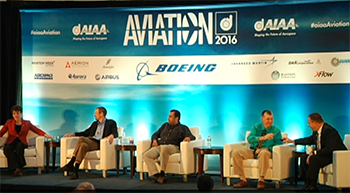Aircraft Designs Test the Limits of Regulation, CFD Software Simulation Written 17 June 2016
Panelists: Moderator Irene M. Gregory, senior technologist for advanced theory and applications, NASA’s Langley Research Center; Jay Brandon, senior research engineer, Flight Dynamics Branch, NASA’s Langley Research Center; Clay Harden, principal engineer of flight sciences integration, Gulfstream Aerospace; Alan Lawless, chief flight test engineer, Honda Aircraft Co.; Anthony Washburn, senior technologist for aerosciences, NASA’s Langley Research Center
by Hannah Godofsky, AIAA Communications

Aeronautics technology has advanced beyond what FAA regulations were originally written to cover, and although computational fluid dynamics has helped reduce the cost and time burden of aircraft testing, it is not yet a finished science, experts said June 16 during the panel “Aircraft Design and Testing: Today and Tomorrow” at AIAA AVIATION 2016 in Washington, D.C.
Clay Harden, principal engineer of flight sciences integration at Gulfstream Aerospace, explained that regulatory uncertainty is a challenge for aircraft designers.
“The regulatory framework is not all that clear; it’s not readily predictable,” he said, adding that other regulations are outdated and are from the era of aircraft controls dependent on cables, which are now obsolete.
“Digital flight control technologies don’t fit within the existing regulatory assumptions,” Harden explained.
International agencies can complicate compliance needs for aircraft designers as well. For example, the FAA and EASA do not have the same regulations regarding ice on business jets.
During preliminary design, Harden said, requirements aren’t always clear, which can make it difficult to outline requirements for new aircraft designs. He cited how some new aircraft stall unconventionally and said with current regulations, the operating speeds designers have to aim for become a hazy moving target.
“We don’t know what that definition may be until we’re well underway with the certification,” he said.
Harden highlighted the limitations of using CFD to optimize aircraft design.
“We’re now using CFD in industry even more than the producers of the CFD are aware of,” he said. “We’re now using CFD to design the entire airplane. And then we’re using wind tunnel and flight test to simply validate those models. We’re assuming that when we go into the wind tunnel or the flight test that we will find only small differences that we need to account for. The problem is, we are often wrong.”
Anthony Washburn, senior technologist for aerosciences at NASA’s Langley Research Center, said in some areas, CFD is still not yet adequate to explain what occurs in wind tunnel tests.
He said in the past, it had been believed that modeling would eventually become entirely predictive of real flight but that today, the systems have “severe impacts of erroneous flight prediction.” He cited uncertainty in boundary conditions and measurement uncertainty as potential root causes for the inaccurate models.
Washburn also cautioned that CFD is not a panacea for every problem with aircraft design.
“We really have no idea how much the perfect high-fidelity simulation might cost us, even with supercomputers of the future,” he said.
Current CFD modeling techniques can save firms a lot of money, but getting beyond the limitations of established software modeling products could have diminishing returns, Washburn said, citing figures showing it could take up to 2,000 MW of power to solve some of the CFD 2030 problems.
“Even in the future, we don’t know how long that might take,” he said.
Video
